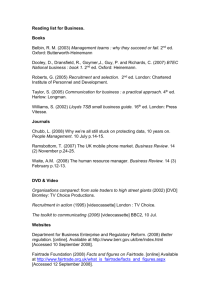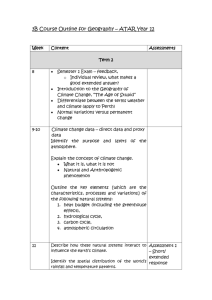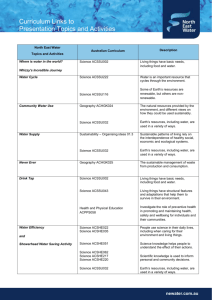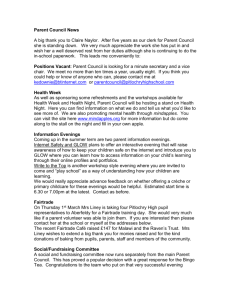Sustainability - Teachers Learning Circle
advertisement
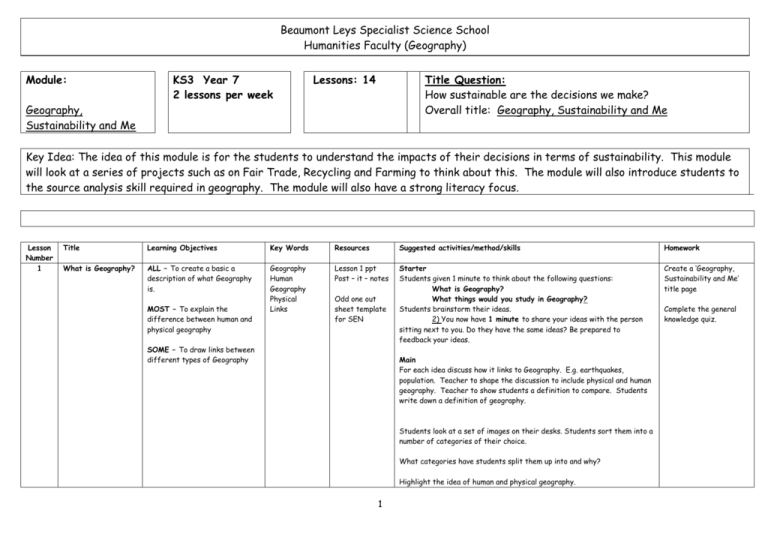
Beaumont Leys Specialist Science School Humanities Faculty (Geography) Module: KS3 Year 7 2 lessons per week Lessons: 14 Title Question: How sustainable are the decisions we make? Overall title: Geography, Sustainability and Me Geography, Sustainability and Me Key Idea: The idea of this module is for the students to understand the impacts of their decisions in terms of sustainability. This module will look at a series of projects such as on Fair Trade, Recycling and Farming to think about this. The module will also introduce students to the source analysis skill required in geography. The module will also have a strong literacy focus. Lesson Number 1 Title Learning Objectives Key Words Resources Suggested activities/method/skills Homework What is Geography? ALL – To create a basic a description of what Geography is. Geography Human Geography Physical Links Lesson 1 ppt Post – it – notes Starter Students given 1 minute to think about the following questions: What is Geography? What things would you study in Geography? Students brainstorm their ideas. 2) You now have 1 minute to share your ideas with the person sitting next to you. Do they have the same ideas? Be prepared to feedback your ideas. Create a ‘Geography, Sustainability and Me’ title page MOST – To explain the difference between human and physical geography Odd one out sheet template for SEN SOME – To draw links between different types of Geography Main For each idea discuss how it links to Geography. E.g. earthquakes, population. Teacher to shape the discussion to include physical and human geography. Teacher to show students a definition to compare. Students write down a definition of geography. Students look at a set of images on their desks. Students sort them into a number of categories of their choice. What categories have students split them up into and why? Highlight the idea of human and physical geography. 1 Complete the general knowledge quiz. Students write a paragraph explaining what they think geography is. Students to read out their paragraphs. Introduce PEE to structure their writing. To support students writing, students are to use the pictures as ‘evidence’ to help describe what geography is about. Extension Students use the pictures to create their own ‘odd one out’ game. Plenary 2. Sustainability All students to understand what is meant by sustainability Most students should be able to explain how sustainability is important to geography. Sustainability Fossil fuels Greenhouse gases Carbon dioxide scanning Lesson 2 ppt. ‘Sustainability literacy task’ Starter Recap questions from lesson 1 • What is geography? • What is the difference between human and physical geography? Starter part 2 Show students a picture of coal, oil and solar panels. Ask them ‘which of these sources of energy will last the longest. Students to order the items and justify their reasoning. Some students could use examples to synthesis their own explanations of what sustainability is. Main Teacher question students thinking from the starter and shape the discussion around the concept of sustainability. Show students 4 definitions of sustainability. Students to select which one is best and write that down. Teacher to explain correct definition and what the concept means. Students given ‘sustainability literacy task worksheet’ to learn more about sustainability. As a whole class read through the information. Introduce questions they will need to answer in books based on article they have read. Model the technique of ‘scanning’ to find the answers from the article. Students then answer the questions in their books. Students swap books with the person next to them. Teacher goes through answers with the class. Peer mark answers as we go. Skimming task: Students re-read the article. Students to write down 10 important words that summarise the article. Students then have to write their own summary of what the article was about. Plenary • • 2 Write down what sustainability means in your own words. Write down at least one example of something that is • 3. Sustainability and Energy Use All students must be able to describe what is happening to the polar bear’s home. Lesson 3 ppt. Story board template. Planet earth DVD disc 1. Polar bear assessment sheet Most students should explain why polar ice is melting faster than it naturally would. Some students could explain how polar ice melting links to you and me. sustainable. Write down at least one example of an activity that is unsustainable. Starter-recap Students shown 5 different methods of transport. Students to rank these transport methods in order from most to least sustainable for the environment. Students to justify their answers. Show a picture of a polar bear on melting ice. Students to write a headline for the picture. Discuss what is happening to the polar bear’s habitat. Main Watch planet earth clip 3 minutes 48.... On disc 1, to show what the polar bear’s habitat should look like. Students to use PEE structure to describe the polar bear’s home. To help students, teacher to lead a class brainstorm on keywords from the clip that we could use in our descriptions. Write these on the whiteboard. Stress to students that this piece of writing will be levelled, so do your best. Homework Students to find out 3 facts about global warming. Read the article and complete the question about penguin migration due to climate change. Explain that we will now work backwards to try to see what has caused the polar bear’s home to melt. Use the ppt to show a series of slides use simple language to tell the story of global warming-greenhouse gases and how this links to us and our energy use. Students to create a storyboard to explain what has happened to the polar bear and how this links back to us and our energy use. Teacher may need to give an example story line. E.g. “Box 1-turning on the TV”, “Box 2a power station”, “Box 3-greenhouse gases in the atmosphere”. Etc. Plenary Play ‘Just a minute’ game. You have to talk for 1 minute without stopping about why the polar bear’s home is melting. ...remember to try to include the word sustainability. • • 4. “Sustainability, Me and the 2012 Olympics”. All students must be able to list examples of sustainable and unsustainable activities. Most students should be able to describe an example of how the London 2012 Olympics is aiming Sustainability Olympics Legacy Lesson 4 Ppt Sustainability wordsearch. Sweets as prizes. Sustainability opinion line. 3 Starter a) Students complete the sustainability word search. b) Prize available for anyone who can explain what sustainability means in geography. Main Students are given a sustainability opinion line and several statements of Students are to complete their ‘sustainability poster’ that they began in the lesson. Read the paragraph to be sustainable. Olympics Article. Some students could evaluate the sustainability of their own lifestyle and consider ways to increase sustainability. different activities. Students must cut out and sort the activities by how sustainable they are on the opinion line. Students must now justify their opinions. • I think that............ Was the least sustainable activity. This is because... • I think that............ Was the most sustainable activity. This is because... • I disagree with the person next to me about.... because.... Literacy Task: 1. Read the Olympics Article as a class. (take it in turns to read a sentence). 2. Underline information about how the Olympics is aiming to be sustainable. 3. Comprehension task: The article is missing a title and paragraph headings. Students need to write these in. Discuss as a whole class what heading people came up with. Teacher can also do this to compare. Students create a split poster entitled ‘Sustainability and Me’. They should sketch or stick in a picture of themselves in the middle. Then on one side should be about things they do that are quite sustainable. The other side should be ways that they could improve and be more sustainable. An example is included in the ppt. Plenary Associations game: Students must each say a word or short phrase associated with sustainability. Students sit down (out) if they are too slow or can’t think of anything. Last person standing is the winner. 5. Fair Trade All students must be able to list several FairTrade products. Most students should describe some of the aims of FairTrade. Some students could explain how the FairTrade logo helps to promote the FairTrade message. Fair Trade Product Trade Lesson 5 ppt Internet access for fair-trade video clip. FairTrade info sheet. Starter Show students a large number of items (that happen to be Fair Trade). Students are to write down as many ideas as they can. Discuss ideas. Hopefully some will spot the FairTrade logo. Explain that we are going to be doing a project looking at Fair Trade and the geography linked to it. Main Teacher to introduce who FairTrade are and briefly explain what they do. Students to brainstorm as many FairTrade products as they can think of. Alternatively, give students 30 seconds to memorize slide 1. Students then have to do their brainstorm from memory. Students feedback what they wrote down. Show students a picture of the Fair trade logo. Ask if anyone recognises it. Students given 30 seconds to memorize the logo and slogan. Screen is blanked and students have to sketch the logo and slogan from memory. 4 about how the 2012 Olympics are being made sustainable. Literacy Task Students use PEE structure to answer questions. a) How would you describe the logo? -What does it look like? In pairs students discuss what they think the different parts of the FairTrade logo represent. Discuss ideas as a class. Students given a passage of information about Fair Trade. Read through this as a whole class. Students are then given answers from the information sheet. Students have to create the questions. Review the questions students came up with including what the passage said the FairTrade logo represents. Discuss, is it a good logo? TASK: Imagine you are starting up your own company that wants to encourage people to be sustainable with... A) what they buy (like FairTrade) or... B) You could encourage people to be sustainable with their energy use. • Design a logo • Label the different parts of your design to explain what they represent. Extension: Create a slogan for your new company Plenary Students present their logo designs back to the class and explain their designs 6. FairTrade and Me All students must be able to describe the difficult conditions that many poor farmers work in. Most students should explain why Fair Trade products often cost more than other products. Some students could synthesise different opinions about buying Fair Trade products. Lesson 6 ppt Internet access for fair-trade video clip.(it takes 2 mins to download so do this at the start of the lesson) Print out slides 7-40 of Fairtrade products and place these around the classroom. ‘text the teacher’ template. 5 Starter Show students a picture of farming in Africa. Students are to use the 5ws to analyse the picture in as much detail as they can. Teacher to model good analysis techniques through asking questions. E.g. ‘what do the clothes tell us about the people?’ Main Show short video clip of FairTrade Banana production to give students some more idea about who FairTrade are and what they do. (video is hyperlinked to the ppt). Students to Mindmap any facts about FairTrade from the video. Add any other facts you can remember about FairTrade from last lesson. Answer these 3 questions in your books. 1. What does Trade mean? 2. Who does FairTrade try to help? 3. Why does FairTrade try to help these people? Teacher to place examples of FairTrade and non fair-trade products and Homework: Read the newspaper article and create a 5 question quiz to test someone else on it. their prices around the room. Students to go around the room and complete a table comparing the prices of FairTrade and non-FairTrade products. Students to complete the THINK PAIR SHARE question. • Why do FairTrade products often cost a little bit more money than other products? Discuss who the extra money goes to. 7. Fair Trade Where do Bananas come from? Part 1 All students must be able to work sensibly in a group and show respect for other people’s ideas. Most students should describe some of the different people that work in the banana trade. Some students could explain and argue why different people in the banana trade get paid different amounts of money. Lesson 7 ppt Post it notes A banana! Print pages 3-5 for each group from ‘banana split pdf.’ Task sheet. Peer assessment AFL Plenary Students are given ‘text the teacher templates’. Students to text their opinions about whether they would be prepared to pay extra for FairTrade products. Emphasise the need to explain reasons for opinions. Students to read out their ‘text’ paragraphs. Starter Students given a post it note. Students are to estimate the cost of 1 banana. They must also explain where did the money go to? (Who would get it?) Discuss ideas. Main Get students into groups of 5. Students will trace the path of a banana exported from the Caribbean to your fruit bowl at home! Each person in a group will take on the role of one of the following: 1. Banana worker 2. Plantation owner 3. Shipper 4. Shop-owner 5. Importer and Ripener • • Before getting into groups we will read through the role cards to make sure we understand them. The teacher will select someone to read at random. If selected you must read up to the next full-stop. Now students get into groups. Students need to read the information on their ‘role card’ (printed from the ‘banana split.pdf.’) Then complete the task sheet individually to think about how much of the 30p cost of the banana should go to their person. The groups then add up the totals from their roles.(It will probably come to much more than 30p). Teacher to write these on the board. Each person now gets a chance to present their argument to the group. (Each person wants the most they can of the 30p, but you must all agree) As a whole class, talk about what makes for healthy group discussion and 6 what ruins good discussion. Teacher could model how to disagree with someone but still showing respect for their opinion. The group must agree on the proportions each role in the banana trade should get. Write this down on the split banana sheet. This must add up to 30 pence! Each group will now need to prepare a presentation explaining how you have divided the 30p. Students must clearly explain why each person has been given the amount of money they have. Each person must be part of the presentation. Practice your presentations read to present to the class at the start of next lesson. Inform them that another group will be assessing your presentations next lesson. Plenary In your books write down: • What has been easy about this task working in groups? • What has been most challenging about this task? 8. Fair Trade Where do Bananas come from? Part 2 All students must be able to describe the different levels of pay for different people in the banana trade. Most students should explain why the pay is not split evenly and justify whether this is fair or not. Lesson 8 ppt Peer Assessment sheet. Summary sheet. Some students could suggest ways to make the banana trade fairer for all. Whose prediction at the start was closest to 30p? ...That person wins a banana! Starter In your books write down 3 facts about the ‘banana workers’ that you learnt about last lesson. Main Students to get back into their groups from last lesson. Students to give their presentations. One other person in the room will assess each person in the group. This means that each individual will get personal peer feedback. (see ppt slide 4). After the presentations students review their feedback scores and stick these into their books as evidence. Teacher reveals the actual ‘banana split’. Discuss and then write down answers to the following questions in response: 1. What are your first reactions to this? 2. Do you think this is fair? 3. Describe who has the power in this trade? Show video clip of an interview with a fair-trade farmerhttp://www.fairtrade.org.uk/resources/films/interview_with_con rad_james.aspx 7 Homework Pick one other fair trade product. Find out why that product is often not produced sustainably. Find out how fair trade helps promote fair-trade with that product. E.g. chocolate or coffee. Students have to imagine that they are one of the thousands of struggling farmers. 1. Write a diary extract to describe how they might feel about the situation. (you could explain the different emotions they might have: e.g. Sadness but angry with ....) 2. In your diary extract, explain what could be done to improve this situation. Extension task Students read the ‘summary sheet’. Students to summarise what this article is about in just 5 sentences. Plenary Caption competition. Students are shown a picture of a smiling Fairtrade farmer. They must complete a caption that starts “I am happy in this photo because...” 9-10. Fair Trade Leaflet Designs All students must be able to use a map to describe the location of where bananas are grown. Most students should be explain why people have different opinions about Fair Trade. Some students could create a convincing Fair Trade advert, targeted at teenagers. Lesson 9-10 ppt Atlas option for starter. ‘role cards’ Geography Skills Starter Show students a world map of places where bananas are grown Describe where bananas are grown (4 marks) (use point, evidence, expand). (Use the Atlases page 70-71 if you want to look up some country names) Main Show students a Fair Trade banana costing 35p and another banana costing 29p. Ask students to write down reasons for and against buying each one. ‘instruction sheet’. ‘card sort’ Fair Trade Chocolate Buttons as a prize for the best Leaflet Designs. Explain that not everyone feels the same way about Fair trade. Ask students who might not like Fair trade? Literacy Task: We will read 3 different views. • One is a Fair Trade representative • One is the boss of a large international company • One is a shopper in the UK. Students then complete a structured summary table on the role card worksheet that will help them understand the different viewpoints. Extension Task: Students synthesise a viewpoint for a teenager in the UK. Give student the design brief that they must create an advertising campaign for Fair Trade that targets teenagers. Go through the design brief instruction sheet, so that students know what to include. 8 Homework is to bring in any pictures or facts, to help create their Fair Trade advert. Finish Leaflet at home if not completed in class. Explain that this will be used to assess how well they understand Fair trade and how well they can explain its aims to improve sustainability. It is also testing their ability to be persuasive in their writing. Plenary Swap designs with the person next to you. • Write down 2 things you liked about another person’s leaflet so far. • Write down 1 thing that they could do to make it even better during next lesson. Lesson 10 Starter Students will be given ‘card sort’ with information on them about Fair Trade. They need to sort them into 2 piles: FOR and AGAINST Fair Trade. Review answers. Main Students are to complete their leaflets Plenary To review the FairTrade topic, get students to mindmap everything they know about ‘Fair trade’ and the ‘banana trade’. Students are to go around the room and borrow 1 idea off another person to add to their mind map. 11. Where does my stuff come from??? This mini topic will look at the geography of ‘our stuff’ and how it links us to different places and the people living there. We will also explore ‘how Sustainable is my mobile phone?’ All students must understand that the things we buy connect us to people in other parts of the world. Most students should be able to explain the impacts of our products travelling long distances. Interdependenc e Place Atlas Scale Lesson 11 ppt. Blank World Map Atlases Starter Everyone must pick 5 different items that they have with them. For each item write down where it comes from. (e.g.check shoe labels) e.g. Teachers stuff: 1. Board remote control: “Made in Malaysia” Main Teacher to show 5 items on ppt. Students to predict where they came from. Teacher to reveal answers. Teacher to introduce the concept of interdependence and how places are connected. Some students could evaluate whether buying from abroad is a bad thing. Atlas Locating places: 1.Students to look back at the teacher’s items Use an Atlas to: (p.70-71) • Use blank world maps to create their own maps showing where each item comes from. Colour in and label these countries. Extension: Work out approximately how far each of those items have travelled to get here. (Teacher to model how to search for a place using 9 Homework: Complete the Lesson 11 homework worksheet where students go to http://www.climatech oices.org.uk/pages/fo od1.htm ...and explore where different foods come from that we eat. the Atlas Index and how to pick information from the Atlas.) 2. Now look at their own items from the starter... • Where did they come from?-(add the locations) to your map • Work out how far your stuff has travelled to get to you. (Teacher to model how to use the scale to quickly estimate distance) Discuss how far the stuff in our class has travelled to reach us. Teacher to show on ppt examples of ‘food miles’ for some typical food products. Students to complete a THINK PAIR SHARE activity, for the questions on slide 11: Why does the stuff we buy come from so many different places? Is it SUSTAINABLE for our stuff to come from all over the world? Link the SHARE part of the discussion back to sustainability and the impacts of greenhouse gases from transport. Students are given the statement: “Buying Kiwi fruit grown in New Zealand is a good thing” Students to explain in their books whether they would agree or disagree with this statement. Ensure that clear reasons are given. Extension-Encourage the most able students to consider this from different people’s perspectives. Plenary Ask: What could the link be between today’s lesson and learning about mobile phones? (students to write down what you think the link is). 12. Who does your Mobile Phone Connect you to? All students must be able to state countries that their mobile phone ‘connects’ them to. Most students should describe what has happened to Mobile Phones use in Africa. Some students could explain the reasons why mobile phones ‘connect us’ to different places. Lesson 12 ppt Phone graph ppt slide printed Phone worksheet. 1 or 2 copies of each of the places stuck around the room. 10 Game: “Associations”- Linking ideas together (interdependence) The teacher will say a word e.g. ‘table’. The next person has just 3 seconds to say a word that is associated e.g. ‘chair’. The next person then has to say a word linked to ‘chair’ etc. You are out if you are too slow if you repeat what was said earlier. Starter Show students a picture of a mobile phone. Students have to think of and write down as many Geography questions as you can think of about a mobile phone. E.g. where was it made? Main Give students 2 minutes to list the different parts that make up their mobile phone. Explain that today’s lesson will explore how are phones connect us to different parts of the world. Geography skills: Give students a ‘phone graph’ showing the number of phone users in Africa. To improve their graphical literacy, they start with answering some basic questions about the graph. They then are asked to describe the overall pattern. Around the room is information on each of the places a typical mobile phone will ‘connect’ you to. You need to go around the room and read the information carefully in order to fill in your worksheet. Students to feedback what they wrote down for each place. Extension: Highlight the countries (using the same colour) that our mobile phones connect us to. Do this on the map that we created in the previous lesson. Plenary-on a post it note Write down 2 things you have learned from this lesson. Write down 1 question you have about the topic. 13. ‘Blood in the Mobile’ This lesson will also get students thinking about sustainability not just in terms of the environment but also for people. All students must understand why mobile phones are linked to the Democratic Republic of Congo (DRC) in Africa. Most students should describe the difficulties that the mobile phone trade has brought to many people in the DRC. Lesson 13 ppt. Internet access with EMBC log in Coltan News article. Some students could be able to explain why the situation in the DRC is unsustainable and how it could be improved. Starter Complete true or false quiz (on ppt) about mobile phones. Explain that in today’s lesson students need to work out what is meant by the phrase ‘blood in the mobile’. Main Show students images of a phone, a Coltan mine, Coltan and the miners. (Ppt slide 4) Think Pair Share. Students must decide what the picture show and come up with a narrative that links allthe picture together. Teacher use ppt slides to explain the relevance of Coltan mining to mobile phones. Teacher discuss the negative impacts of mining on the environment. 1. Watch ‘Blood in the Mobile’ clip. http://www.youtube.com/watch?v=7z8nxxklDHE (use EMBC log in to get access) 2. Read Coltan News article as a whole class. There are several words blanked out. At each blank pause and get students to suggest a word that could fill in the blank. 3. Students answer the following questions in your books. a)What is meant by blood in the mobile? b) Explain: Is mining in the Congo sustainable? c) Suggest how could this situation be improved? Show students a few picture depicting the difficult conditions and lives that Coltan miners often have: Students must write just 5 words to describe the working conditions. Write a short diary extract entitled “A day at work for a Coltan Miner in the Congo”. 11 Homework: Complete homework worksheet 13-14 looking at a news article on the human conflict in the DRC linked to mining. Spend some time working on your Mobile Phone booklet telling people where their phones come from. Your job is to find out any facts, pictures or maybe newspaper articles about Coltan Mining. Print these off or email them to your teacher to print. Explain that next lesson students will need to create an A4 (folded) information booklet telling people where mobile phones come from. As such it is essential that the homework is completed for next lesson. Plenary Read out your diary extracts to the class. Question students on why the situation in the Congo currently unsustainable for people and the environment? How could things be improved? 14. Blood in the Mobile part 2 All students must understand why mobile phones are linked to the Democratic Republic of Congo (DRC) in Africa. Most students should describe the difficulties that the mobile phone trade has brought to many people in the DRC. Lesson 14 ppt Print ppt slide 4 (instructions to include in the booklets) Text the teacher template Some students could be able to explain why the situation in the DRC is unsustainable and how it could be improved. Starter Students answer 5 questions (ppt slide 1) as a mini test reviewing the whole SOL. Main (you could allow students to do this in pairs) Explain that next lesson students will need to create an A4 (folded) information booklet telling people where mobile phones come from. • You job is to create an information booklet explaining the different places that are mobile phone comes from. • You should also warn people about what is happening in the Congo. Things that students should try to include: • Make up a title: • Include information on the different places that are linked to the mobile phone market. (use your information sheets from lesson 12 to help). • Warn people about what is happening in the DRC (Congo) • Suggest how the mobile phone industry could be made more sustainable for the future. • Brighten it up with pictures, photos, speech bubbles saying what different people might think (e.g. A Coltan miner), facts and figures etc. Plenary You can send 1 text to the boss of a large phone company. You have to convince them to improve the phone industry to make it more sustainable for the people in the DRC. 12

